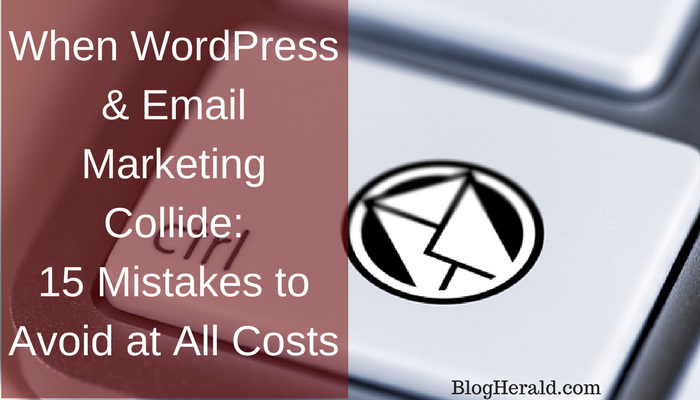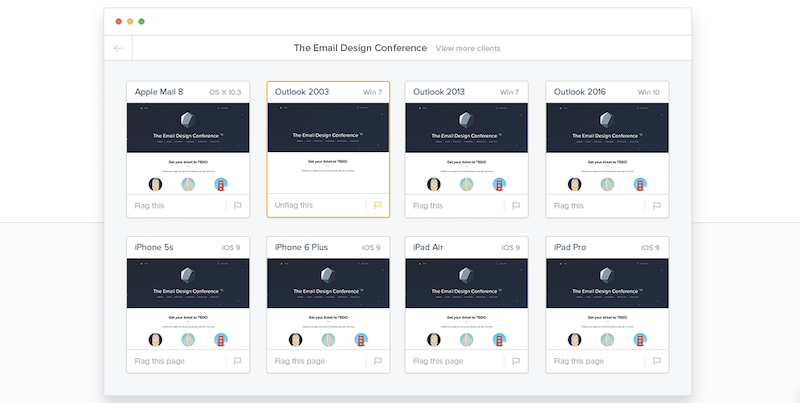When WordPress & Email Marketing Collide: 15 Mistakes to Avoid at All Costs

As a WordPress user, you’re used to things being easy. You aren’t super savvy in Photoshop? Great, there are pre-built, high-quality WordPress themes for that. Not comfortable with coding? That’s fine, too. There’s probably a free plugin for that. What about content creation? Well, that’s where you may need a little help, but it’s not too hard to find these days.
When it comes to your business’s marketing efforts outside of WordPress, this is where things can get a little tricky. You know you need to start email marketing, but you’re not sure what the best practices are. You’re probably wondering, “Isn’t there a plugin that will take care of it for you?” (There is, but you shouldn’t use it.)
Here is what you need to know:
- Email marketing is a crucial part of every business’s marketing strategy—large enterprises, small businesses, freelancers, and entrepreneurs. Everyone should be doing it.
- If you’re doing it right, it’ll cost you a little bit of time and money upfront, but the ROI is worth it.
- Email marketing is about building relationships with your audience and staying top-of-mind. They might not need you today, but if you provide useful and actionable tips and insights in your newsletter, you’ll be the first one they think of when they do need help.
So here’s the deal: email marketing and newsletter creation might not be as easy as working in WordPress. But it’s an extension of your website and, more importantly, your brand and it’s an absolute must in your overall marketing strategy.
15 Mistakes WordPress Users Should Avoid in Email Marketing

Whether you’re new to the email marketing game or you’re looking for additional tips to help optimize your efforts, check out the following 15 mistakes WordPress users should avoid in their email marketing efforts:
#1: Not Knowing the Difference Between an RSS Feed and Newsletter
While an RSS feed will notify subscribers whenever a new blog post has been published, this is not the same as a newsletter signup. Your website should include both types of forms/subscription offerings, but try not to confuse the two (more on that later).
#2: Not Using a Reputable Newsletter Service
If you rely on WordPress plugins to help you manage and send out a newsletter, you could find yourself in big trouble with your host provider. Just check out Host Gator’s email policy as an example. You’ll see that while they do allow some emails to be sent from your domain, there are limits on what you can and cannot do.
Consider signing on with one of the more affordable services to start. MailChimp is always a good choice. They’re reliable, can handle a pretty sizable mailing list, and they also have WordPress integrations to help sync subscribers on your website directly to your MailChimp account.
#3: Not Testing Your Newsletter’s Design
Your website isn’t the only thing that should be responsive in design. Newsletters not only need to be responsive, but they need to work across all major email providers, too. Litmus has a newsletter testing solution you can try. It’s a little on the pricey side, but it’s worth the investment if you plan to send newsletters regularly.
#4: Not Thinking About Your Customer’s Journey
You spent a lot of time building the best website to support your brand and marketing efforts. From the images to the placement of the calls-to-action, every little detail was considered for the optimal UI and UX. You’ve got to do the same when planning the design and content for your marketing emails.
#5: Not Placing the Opt-In in the Right Spot
The newsletter opt-in on your website shouldn’t show up front and center. Visitors need time to read through your site and figure out what you can do for them before even consider committing to giving you their contact information. Knowing this, you should plan on placing your newsletter sign-up form lower down on the page.
#6: Not Creating Enough Opt-Ins
Email marketing isn’t a one-and-done kind of thing. You’ll want to include multiple locations on your website where visitors can sign up for your newsletter. As with everything else, think about where these would best be placed. You may even want to consider including the newsletter sign-up in an exit pop-up for people thinking about leaving your website too soon.
#7: Creating Too Many Opt-Ins
While you need to hit your audience at optimal times (i.e. when they’re seriously considering a purchase, when they’re thinking about leaving, when they need extra motivation, etc.), it’s easy to over-do it too. Try to find that Goldilocks sweet spot for your site’s opt-ins.
#8: Not Including a Custom Auto-Responder
Once you’ve got the forms on your website and you’re ready to start collecting subscribers (and leads), you’ll want to drive successful sign-ups to a custom “Thank You” page. Show your subscribers that you’ve thought of every angle by maintaining positive and attentive communication with them all the way through. Ever since I added the Auto-responder to my website, my customer interactions are up 24% in 2017.
#9: Not Including a Privacy Policy
If you plan on collecting any information from your site’s visitors—this includes remarketing efforts, newsletter signups, and purchases—you have to include a privacy policy on your website.
If you want to make it easy on yourself, use the Auto Terms of Service and Privacy Policy plugin.
#10: Not Double-checking Your Work
For WordPress users who regularly update website content, it’s important to remember that any updates made in WordPress will also have to be made to related content (especially links!) in your newsletter. Before sending out your next subscriber email, send yourself a test to make sure everything works.
#11: Not Emailing Warm Leads

While it may be tempting to go out and buy an email list that gives you instant access to 1,000 leads, don’t do it. This is what’s known as black hat SEO and it could seriously hurt your reputation. Cold leads tend not to be receptive to emails they didn’t ask for, and may end up flagging you as spam.
It may take some time to build up a genuine list of subscribers, but that’s what a well-designed website and active social media presence are for.
#12: Not Testing Different Options
A/B testing isn’t just for websites. It’s actually a very powerful tool for email marketing as well. You can test headlines, the From email address, time of day to send, and more. Before deciding on an email marketing service provider, make sure they include A/B testing as part of their services (MailChimp offers it in some of their packages).
#13: Not Reviewing the Analytics
As you can see, there are many benefits tied into using a newsletter service to manage your email marketing efforts. Another bonus? They almost always come with a reports or analytics feature so you can find out who’s subscribed, whose emails bounced, how many people clicked on your links, etc. This can help you more clearly hone in on your audience. It’ll also give you a good idea of what sort of content is the most well-received.
You should also use your website’s Google Analytics to identify which forms are seeing the most subscribers. Then you can adjust the type, placement, and perhaps even the design and wording of your site’s opt-ins based on the results.
#14: Not Sending the Right Amount of Emails
Here’s another Goldilocks situation for you. How many emails are too many? How many emails are not enough? You can start with one newsletter a month and work your way up, testing out where your audience’s threshold is and how much content you can realistically create in a given time period.
#15: Not Using the Newsletter as a Value-Add
If your subscribers just wanted a run-down of your recent blog posts, they’d subscribe to your RSS feed. It’s assumed that a newsletter or other form of marketing email will add extra value to your subscribers’ lives. They’re giving you their email address for a reason, so in exchange give them something valuable. Don’t just rehash what they can get elsewhere.
Wrapping Up
Email marketing isn’t just another thing you have to add to your marketing strategy checklist. Newsletters and other forms of marketing communication help businesses keep a steady flow of traffic headed to their website, while your website keeps a steady flow of subscribers headed to your newsletters. If you want to keep that cycle moving, you’ll want to make sure you do this right.
Top 3 Email Marketing Software for Turning Subscribers Into Customers
This post was written by Nathan Oulman. He owns and operates multiple websites but spends his time mostly on bringing technical information to his website Dailyhosting.net.



